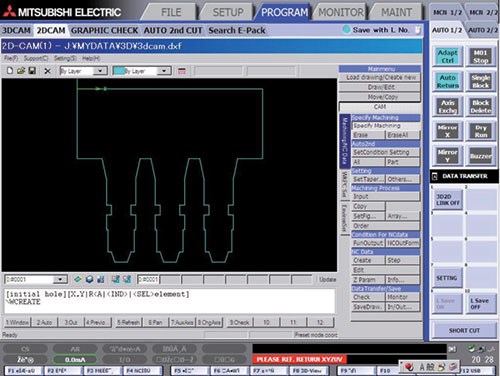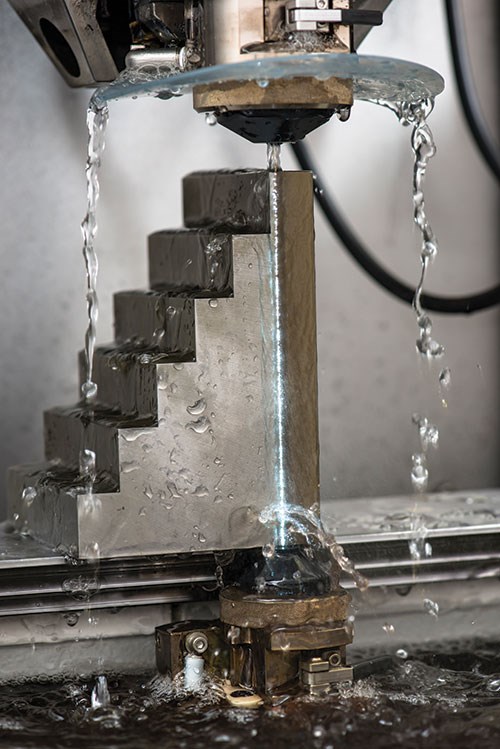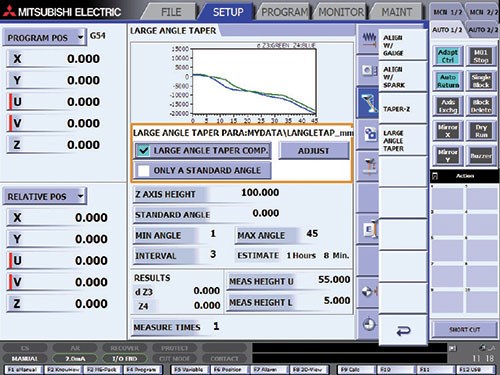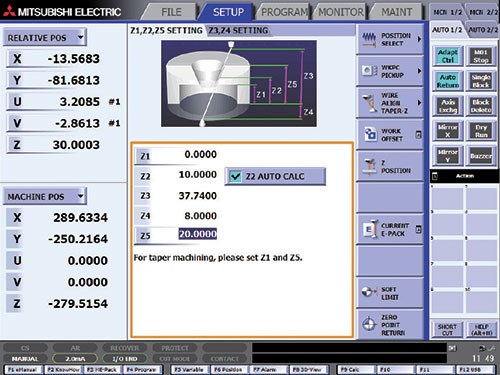Wire EDM Goes 3D CAM for Moldmaking Operations
New features, technologies and software make wire EDM well-suited for tackling solid models, and improving taper angles and surface finish.
Moldmakers routinely turn to wire EDM to hold incredibly tight tolerances or to create incredibly complex shapes. However, moldmakers present a unique suite of specialized needs and face specific challenges—whether that means increasing taper accuracy on shutoffs and slides, improving overall surface finish, or achieving better accuracy on contours and angles.
Over the years, EDM has evolved in many directions to suit a range of applications and operations, but wire EDM has recently introduced certain features that specifically lend themselves to the different types of cuts required by molds, which brings an EDM machine more into the world of 3D CAD and solid models than ever before.
Importing 3D CAD
New wire EDM systems allow the importing of 3D CAD (parasolid) files, and these 3D model contour files are then extracted via the on-board 3D CAM software. This feature provides the ability to bring a solid model file into the control and set the wire cut height to generate the NC cutting profile, including machining conditions, and then uses the 2D CAM software to create the NC program for the machine to follow.
This can also be done in a two-level height setting, which then generates a four-axis taper profile as required by the model. An example of this capability is a part with a taper larger than what the machine’s U-V travel can handle. The height of the part can be sectioned into layers to where the angles can be generated. Dowel locations are then added for proper location for assembly, similar to a layer cake.
Each layer’s top and bottom levels can be selected through the solid model thickness, and the 2D CAM will generate the shapes at those heights. This process has also been used for plastic and aluminum extrusion dies that normally start with a round top opening and progress down through the layers, turning into the finished part shape, which can be very complicated.
A simple example would be to picture a circle at the top of a three-inch thick block with a letter of the alphabet at the bottom. This may need to be split into three, 1-inch thick layers to provide enough U-V travel to create the required taper angles.
Analyzing 3D Data
This same solid model information is then used by an advanced programming CNC control, which analyzes 3D data and recognizes shape characteristics. By analyzing this 3D data, it establishes all the positions where the height differences, cavities and interruptions in the workpiece are located. It will then optimize the machining speed to determine exactly when and where to reduce power in the transition areas, thereby eliminating the possibility of wire breaks due to sudden thickness changes. This enables the machine to perform at an optimum productivity level with minimal operator intervention.
An additional benefit of the control feature is the reduction of transition marks or lines when machining through different thicknesses or cavities in the material. Reducing these lines ultimately provides a smoother finished surface and reduces secondary polishing time, which makes for higher-quality components than were previously attainable.
Enhanced Taper Cutting
Another new wire EDM feature that is well-suited for moldmaking operations is an enhanced taper cutting system that consists of special wire guides and software that can create more accurate taper angles over a wide range of angle changes. The guides allow the wire to pivot smoothly over a larger guide radius to achieve the highest-possible precision at any angle. This benefits surface finish as well, enabling one to achieve a 12-micro-inch surface roughness (Ra) at angles as large as 45 degrees and reducing secondary polishing time, which enables the customer to make the parts less expensively.
When the taper is generated on a wire EDM, the U-V axes move the upper guide independently from the bottom guide to generate the angle. This creates a situation where the wire is pushed to the side, making contact with the side of the diamond insert in the guide. This specific contact location on the guide radius is known as the angle point of deviation, and it changes as the taper angle increases.
The setup software tracks and stores these deviation points for a wide range of angles, and then it automatically adjusts the machine’s U-V position to create a more accurate taper angle. The smooth, large radius of these guides reduces scraping on the wire surface, which in turn helps to produce a much finer workpiece finish than with standard guides.
Summary
New software technology enables EDM machines to address the solid operations common to moldmaking applications more efficiently and more accurately than ever before. As such, moldmakers are turning to wire EDMs as a solution for optimizing productivity, performing precision taper cuts and providing the best available surface finishes.
Related Content
Treatment and Disposal of Used Metalworking Fluids
With greater emphasis on fluid longevity and fluid recycling, it is important to remember that water-based metalworking fluids are “consumable” and have a finite life.
Read MoreHow to Eliminate Chatter
Here are techniques commonly used to combat chatter and guidelines to establish a foundation for optimizing the moldmaking process.
Read MoreThe Ins and Outs of Hot Runner Temperature Control
A training checklist that explains the why and how of proper hot runner temperature control and system management.
Read MoreIt Starts With the Part: A Plastic Part Checklist Ensures Good Mold Design
All successful mold build projects start with examining the part to be molded to ensure it is moldable and will meet the customers' production objectives.
Read MoreRead Next
“Fixing” to Get More Accurate, Increase Productivity with Automation
The Roku-Roku machine, EROWA workholding system and the EROWA Robot Multi form the production team. Optimally used, this team can deliver up to four times higher productivity.
Read MoreReasons to Use Fiber Lasers for Mold Cleaning
Fiber lasers offer a simplicity, speed, control and portability, minimizing mold cleaning risks.
Read MoreHow to Use Continuing Education to Remain Competitive in Moldmaking
Continued training helps moldmakers make tooling decisions and properly use the latest cutting tool to efficiently machine high-quality molds.
Read More



























